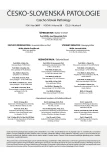Double homicide with a damning bite mark on the offender´s body – case report
Authors:
Markéta Kulvajtová 1; Jiří Hladík 1; Lucie Zemančíková 2
Authors‘ workplace:
Ústav soudního lékařství 3. LF UK a FNKV, Praha
1; Krajské ředitelství policie hl. m. Prahy, SKPV, OOK, 1. oddělení
2
Published in:
Soud Lék., 62, 2017, No. 1, p. 2-5
Category:
Original Article
Overview
The authors deal with a case of a double homicide, the parental murder made by their older son, which was committed by a combination of stabbing and cutting wounds. The perpetra-tor tried to hide the bodies, so he doused them with gasoline and set fire to them on a lonely forest road. Then he ran over the remains by his car. The cause of death was in both cases open wound of the neck - autopsy findings of the woman´s body testified for a blood aspi-ration, on the man´s body it was not clear for a partial charring, so the possibilities were blood aspiration, air embolism or external bleeding with haemorrhagic shock. There were also many other injuries on the bodies, especially of the post-mortem origin. During the combat, one of the victims – the mother – bit the assailant´s left forearm. So a few days after creation the injury on murderer´s left upper extremity, the police technicians took photos and during the forensic autopsies of both bodies, authors created the impressions of the teeth. The utilities were loaned from Department of Stomatology of University Hospital Královské Vinohrady in Prague and they were designed for the general adult population. The work was more difficult for the state of mortal remains, which were damaged by combination of fire and blunt violence. However finally the impressions of each arch were made, and they were given to the experts from Institute of Criminalistic Prague, who compared them with pictures of the bite mark. The results of this analysis were used in a court as evidence against the perpetrator.
Keywords:
double homicide – stab and slashed wounds – covering the crime – bite mark - impressions of the teeth
Sources
1. Pilin A. Termické změny. In: Hirt M a kolektiv. Soudní lékařství I. díl. Praha: Grada; 2015 : 215.
2. Türner AR, Akçan R, Karacaoğlu E et al. Postmortem burning of the corpses following homicide. J Forensic Leg Med 2012; 19(4): 223-228.
3. Fanton L, Jdeed K, Tilhet-Coartet S, Malicier D. Criminal burning. Forensic Sci Int 2006; 158(2-3): 87-93.
4. Štefan J, Hladík J a kol. Soudní lékařství a jeho moderní trendy. Praha: Grada; 2012 : 69.
5. Bohnert M, Rost T, Pollak S. The degree of destruction of human bodies in relation to the duration of the fire. Forensic Sci Int 1998; 95(1): 11-21.
6. Verma AK, Kumar S, Bhattacharya S. Identification of person with the help of bite mark analysis. J Oral Biol Craniofac Res 2013; 3(2): 88-91.
7. Whittaker DK. Forensic densitry in the identification of victims and assailants. J Clin Fo-rensic Med 1995; 2(3): 145-151.
8. Sweet D, Pretty IA. A look at forensic densitry – Part 2: Teeth as weapons of violence – identification of bitemark perpetrators. Br Dent J 2001; 190 : 415-418.
9. Balachander N, Babu NA, Jimson S, Priyadharsini CV, Masthan KM. Evolution of forensic odontology: An overview. J Pharm Bioallied Sci 2015; 7(1): 176-180.
10. Silva RH, Musse Jde O, Melani RF, Oliveira RN. Human bite mark identification and DNA technology in forensic dentistry. Braz J Oral Sci 2006; 5(19): 1193-1197.
11. Franco A, Willems G., Souza PH, Bekkering GE, Thevissen P. The uniqueness of the hu-man dentition as forensic evidence: a systematic review on the technological methodolo-gy. Int J Legal Med 2015; 129 : 1277-1283.
Labels
Anatomical pathology Forensic medical examiner ToxicologyArticle was published in
Forensic Medicine

2017 Issue 1
Most read in this issue
- Double homicide with a damning bite mark on the offender´s body – case report
- Snowball fight - an unusual cause of spleen injury
- Multiple firearm injury caused with a blank pistol
